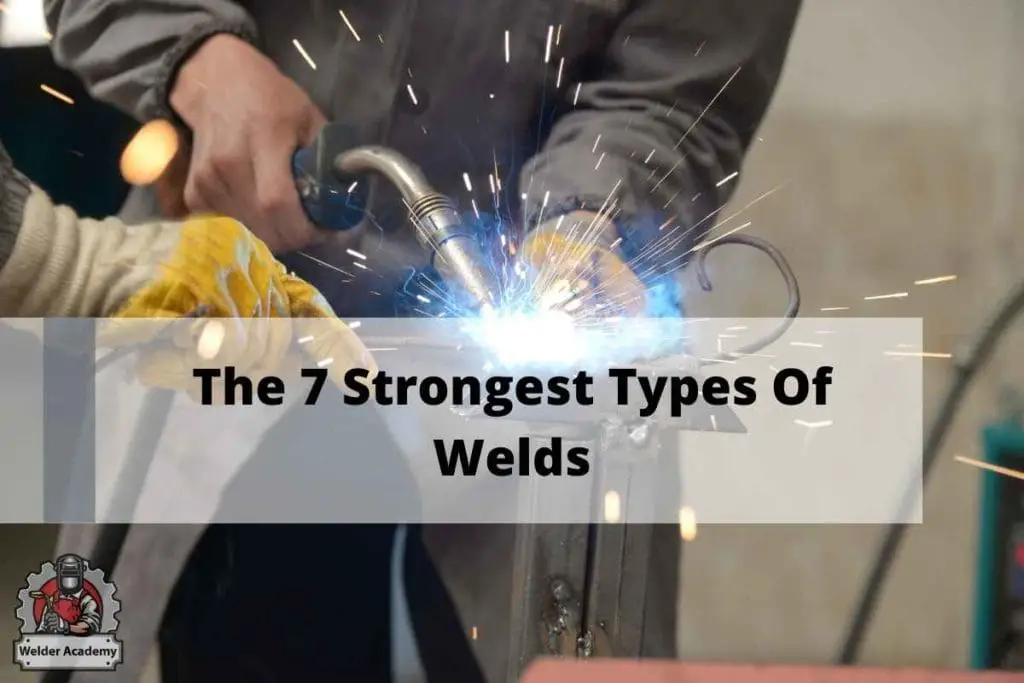Since the invention of welding, there have been countless welding types, each for a different purpose. There are more than 60 types of welding, but not all of them yield the same strength. While the strongest types of welds depend on various factors, the welding type itself is also one of them.
Among the four primary arc welding techniques, TIG welding is the strongest. Stick welding comes next, followed by MIG and flux core welding. Plasma, electron beam, and atomic hydrogen welding are also pretty strong, though TIG welding has now replaced AHW.

This write-up will briefly explain each welding type I just mentioned to give you an overall idea. There will also be a section discussing the significant associated factors behind the strength of welding.
7 Strongest Types Of Welds
As arc welding is the most common welding variation, I’ve chosen to stick to arc welding. It is also the most used at the consumer and industrial level. Here are the seven strongest types of arc welding:
1. TIG Welding
TIG welding, or gas tungsten arc welding (GTAW), is the cleanest welding and produces an immaculate finish. A non-consumable rod is used in TIG welding. TIG welding requires high skill and mastery, and at the same time, it is renowned for its high aesthetic. It is even used for creating art.
TIG welding is used for thin metals, particularly aluminum and magnesium. It is an excellent fit for metals that can’t endure much heat. This welding process has a high deposition rate, which means more filler metal goes into the joint, resulting in a stronger weld. TIG welds are generally solid as long as the weld is neat, clean, and free of splatters.
2. Stick Welding
Stick welding is one of the oldest and most widely used welding techniques. It is formally known as shielded metal arc welding (SMAW). It doesn’t require any shielding gas. The welding rod or filler rod has a covering of flux material. During welding, this flux coating protects the weld pool from environmental gasses and other contaminants.
Stick welding takes longer than any other process, but it’s also easier to master. Stick welding doesn’t require any shielding gas, so it’s suitable for outdoor projects. It is also the welding of choice for underwater welding.
Stick welding is suitable for heavy structures such as cast iron, steel, etc. In terms of sheer strength, stick welding is on top.
3. MIG Welding
Besides TIG welding, another method that is equally suitable for welding aluminum, magnesium, and similar metals is MIG welding. A wire electrode from a spool gun is continuously fed into the weld pool. The tip of the welding gun also delivers shielding gas to protect the pool from atmospheric gasses.
MIG welding is a prevalent technique in the welding industry, right next to stick welding. This welding is easy to do and doesn’t require much expertise. MIG welding is more versatile than stick and TIG welding. You can use it to weld various metals of different thicknesses. MIG welding is the best for most steel types, and its strength is also favorable.
4. Flux Core Arc Welding
Flux core arc welding, or FCAW, is very similar to MIG welding. A wire electrode is fed into the weld pool from a spool gun. But instead of using a separate shielding gas, the electrode has a core of flux material. The flux protects the weld pool in the same way as shielding gas. FCAW is a very suitable technique for outdoor work.
Flux core arc welding has several advantages over other methods. It is excellent for outdoor work as it can withstand strong winds. Flux core welding is preferable for joining thick materials. It has a high deposition rate and a stable arc. Flux core welding is pretty strong, but not aesthetic.
5. Plasma Arc Welding
In plasma arc welding, the electrode stays within the welding torch. It allows the plasma to stay separated from the shielding gas. The plasma comes out of the welding torch through a narrow copper nozzle, which constricts the arch. The differing diameters of the plasma arc and amperage can produce various operating modes.
Microplasma requires 0.1 to 15A, and the arc length can vary up to 20mm. Medium current operates between 15 and 200 A, and keyhole plasma works at over 100 A. The tungsten electrodes can be 1.6, 2.4, or 3.2 mm in diameter.
Plasma arc welding has higher arc density, intense penetration, fast speed, and high efficiency. Due to these characteristics, plasma arc welding has earned its place in this list of strongest welds.
6. Electron Beam Welding
Electron beam welding is a high-energy welding process, and it’s extremely precise. With this welding technique, you can weld varying thicknesses of metals with extreme accuracy, from 0.1 mm to 300 mm in a single pass. Electron beam welding can also join dissimilar metals with ease.
For its accuracy and ability to weld the thinnest of metals, electron beam welding is used to manufacture small and delicate medical electronic devices and complex aerospace components.
Electron beam welding is also notable for its high strength and resilience. This welding takes place in a vacuum environment, so contaminants and impurities have no chance of infiltration. Electron beam welding can maintain about 95% of the strength of the base metals.
7. Atomic Hydrogen Welding
TIG welding has replaced atomic hydrogen welding. But this is the only welding process with the ability to surpass the strength of TIG welding. Atomic hydrogen welding uses two tungsten electrodes to form an arc. The shielding gas here is hydrogen.
The use of atomic hydrogen welding is the same as TIG and MIG welding. It was used to weld stainless steel, ferrous and non-ferrous metals, thin steel sheets, and various other special alloys; and could provide impressive strength.
What Determines The Strength Of A Welding?
The welding type alone can not determine the strength of the welding. There are lots of factors that play a role in it combined. Here are those:
- Base Metal
Base metal is the principal factor behind the welding strength. Steel is more robust than aluminum, so no matter which weld type you use, the aluminum joint can never be as strong as steel joints.
- Filler Metal
Filler metal flows between the two base metals and joins them together. The properties of the filler metal play a vital role in strength. The filler metal properties have to be the same or close to the base metals for optimum stability.
- Thickness of the Base Metal
Thick joints are stronger than thin joints; it’s a no-brainer. Stick welding is best for thick steel and cast iron; TIG and MIG welding work great for thin workpieces. That’s why stick welding is said to have the greatest strength.
- Selection of Shielding Gas
Shielding gas in arc welding can determine the joint strength alone. The gas protects the weld pool from atmospheric gasses. Selection of proper gasses and knowing the ratio, flow rate, etc., is one of the prime determinants of joint strength in arc welding.
Aside from these, preheating, post-heating, proper electrode selection, clean weld area, incomplete penetration, improper joint, etc., play essential roles in welding strength.
Conclusion
The type of weld to choose does not depend on the strength; there are more important aspects. Also, if strength has the most priority, in any case, factors like base metal type, thickness, etc., automatically account for it.
But still, it’s nice to know the strongest types of welds; also, acquiring keen knowledge about all the associated factors is very important.
